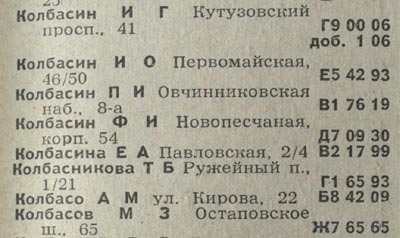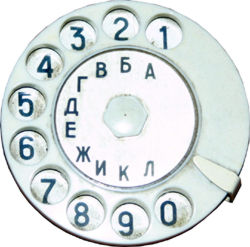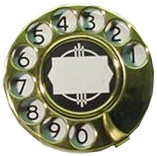|
Artemy Lebedev
§ 91. A short history of telephone numbersJune 18, 2002 |
|
The Scottish inventor Alexander Graham Bell is credited with speaking the first words by telephone on March 10, 1876: “Mr. Watson —Come here—I want to see you”. To call his assistant sitting next door, Bell didn’t have to dial a number: there were only two phone sets in the world at that time. |
 A sketch of a telephone apparatus by Bell (approx. 1876) |
|
Several years passed. Telephone users and sets sprouted like mushrooms. City telephone networks came into being and every phone set was assigned a number. Calling a subscriber would require giving his or her number to the hello girl. |
|
In 1910 the USA, then a country with the highest telephone penetration rate, numbered over 7 million subscribers, which compared to Russia’s 155,000. In the days of old an ordinary telephone number had four digits, while large cities used five-digit numbers. To reach a person beyond city bounds by phone, you would normally have to tell the operator the name of the city and a number. A telephone call used to be pre-ordered, which took some waiting. |
|
In the 1910s automatic telephone switches started to supersede hello girls who made connections manually. By the beginning of the First World War the USA had over 100 automatic telephone switches, Germany—7, Great Britain—2. Moscow saw the first automatic telephone switch installed not sooner than in 1924, and that one was in the Kremlin. The city automatic telephone switch started operation in 1930. |
|
How they did it Americans who were to encounter the problem of 7-digit numbers sooner that any other nation, found a mnemonic solution to the problem (it was generally believed back then that 7-digit numbers were hard to memorize): the first three digits were replaced with letters some word started with. For technical reasons no telephone number in the US started with 1. For historical reasons zero was always used to call the operator. As a result, any American telephone number could start with any figure but 1 and 0. |
|
Mnemonic rules were in use in London and Paris until mid-1960s. At first Americans adopted the LLL-NNNN format (three letters, four numerals). After becoming aware that it was running out of words beginning with the needed three letters, New York introduced the LLN-NNNN format in 1930 with all the other cities following suit in 1947–48. |
|
Telephone numbers were written (and pronounced) as follows: |
 1924. Telephone number TREmont 3106 (873-3106) |
 1948. Telephone number HArrison 7-8723 (427-8723) |
 1960. BUtterfield 8 (288), a film starring Elizabeth Taylor |
|
How we did it Everything associated with a telephone (from telephone sets to stations) came to Russia from the West. In 1881 the American Bell Telephone Company signed a 20-year contract with Russia on installation and operation of telephone networks in St. Petersburg, Moscow, Warsaw, Odessa, Riga and Lodz. |
|
LM Ericsson and Co. opened its first Russian telephone station in 1893 in Kiev. In the late 19th century for the former owner of a mechanical repair shop Lars Magnus Ericsson Russia was the biggest sales market—he even considered moving to St. Petersburg. Here’s how Ericsson described it in the 1997 annual report: “As early as the late 1890s, Ericsson had operations worldwide—including countries such as China, Russia and Mexico”. |
|
In 1900 Ericsson built its first foreign factory in St. Petersburg. In 1927 it was renamed into Krasnaya Zarya (Red Dawn) and started to produce first Soviet telephone sets. |
|
One of Europe’s largest telephone stations owned by the Russian-Dutch-Swedish joint-stock company was located in the Milyutinsky by-street in Moscow (the building is still used as a call center). In 1917 during the Great Socialist Revolution the building with cadets holed up inside was besieged by revolutionary insurgents. Five days into the siege, none of the cadets remained, while out of 60,000 lines only around 10,000 were operating. In 1920 Sovnarkom (the Council of People’s Commissars) decreed that all telephone sets be seized from private individuals owing to a dire shortage of numbers. |
|
Housekeeping tip |
Automatic dialing was possible with a rotary dial telephone set. Prior telephone models were directly connected to the operator or had a magneto (a rotating handle on the right hand side spinning which you also connected to the telephone girl). Telephones with a rotary dial were a rarity. They were only installed in high-ranking officials’ offices (200 lines in the Kremlin and 20 lines in the Russian Council of People’s Economy). This sort of a telephone set was called “vertushka” (“whizzer”). These days this word is remaining in the Russian language to denote a direct government phone in a kingpin’s office, although modern “whizzers” have either a push-button dial or none at all. |
|
The last thing for the USSR government to get worried about in the 1920s was creating a system of mnemonic rules to make the memorizing of telephone numbers easier. At that time numbers like L-NN-NN (one letter, four numerals) were pretty common. Later an automatic telephone switch came into use that had two-letter indices. But each letter being pronounced separately made memorizing the numbers a tall order. Letters followed by numerals were in broad use in the USSR until 1968. |

1968. A notification flyer about abolishing letters in Moscow telephone numbers (from MGTS website):
|

1970. A flyer for city telephone network subscribers issued by the Svyaz Publishing House (from the author’s collection):
|
|
How they used to call The first phones didn’t have a dial. In the Moscow Telephone Network Subscribers Directory published in 1916 the first article of the rules of use reads as follows: “The central station is called by taking the microtelephone off the hook. The operator at the station should answer by telling her number. Afterwards the subscriber shall clearly pronounce the number to which he wishes to be connected”. |
|
The first telephone sets with rotary dials had only numerals on them. In the 1920s letters standing beside numerals came into use. |
In the USA on a telephone dial three letters of the English alphabet used to stand beside each numeral (but 1 and 0). The letters Q and Z were not in use owing to their visual similarity to 0 and 2. |
The English used to place the letter O near zero—they looked the same anyway. |
The Swedish and the German used one letter per each numeral: A, B, C, D, E, F, G, H, J, K, thus taking up all of the ten numerals. The letter I wasn’t used to avoid its confusion with 1. |
In the USSR there were also ten letters standing beside numerals on a dial: А, Б, В, Г, Д, Е, Ж, И, К, Л. The letter З wasn’t used not to be confused with three. |
|
How they call In today’s Russia no telephones with Russian letters are produced. Many European telephones don’t have any letters at all. All American telephones have letters standing beside numerals. |
|
All modern mobile phones (no exceptions) sport the full Latin alphabet (some models also have the Russian one). Here’s where the problem with two ways of using the letters starts. If you are driving on a highway and see the words “How am I driving? Call |
|
But when you type an SMS, letters work in another mode: to choose a letter, pushing the relevant button once is sometimes not enough—you’ll have to push it several times to get the right letter. |
|
The letter dialing system is well-known in the USA: memorizing a word is easier than memorizing a set of figures, although typing them afterwards is awfully hard. Europeans who know what SMS is really have no idea about how the American system works. |
|
In Russia, there’s only one company to risk using this mnemonic method so far to advertise its telephone number—Megafon, a telecom operator advertising the number 500-ALLO (500-25-56) in Moscow. The author doesn’t know whether there has been any success implementing this move. |
|
|||||||||||||
|
Obiter dictum |
After the touch-tone dial was invented in 1961, the position of numerals on a dial was discussed by Bell engineers. Several proposals were in consideration, one of them—positioning the buttons in a circle like on a rotary dial. The idea behind this was that it would be hard for people to bang change over to a wholly new system. However, studies showed that people quickly got the hang of any ordered position of buttons. Therefore a decision was made to arrange the buttons in three rows, three buttons in a row, in the order that people already knew—zero following nine, that is, as on the rotary dial. For a counting machine, though, it is logical to have zero preceding one. |
|
Writing phone numbers correctly |
In France and the Great Duchy of Luxembourg dots or blanks are used to separate numbers (eight-digit phone numbers with an area code): |
In Germany blanks (more rarely—hyphens) are used: |
In Bulgaria a telephone number is always written in three two-digit groups: |
|
A special case is Italy and Holland where telephone numbers are often written in a continuous string of figures with no spaces: XX XXXXXXX, 020-XXXXXXX—a real scourge for people hurting their eyes if not to memorize the number, then at least to make it out. The lack of a separating character is sorely felt in the phone book of a mobile phone when you have to screw up your eyes to pick each of the 10 figures melted together. |
|
In the UK (that has a lot of common with the US in terms of technical standards) phone numbers are written in two groups of numerals: |
|
It’s worth mentioning here that in oral English big numerals are customarily broken down into groups. The year 1998 would be pronounced “nineteen ninety eight”, not “one thousand nine hundred and ninety eight”. Sometimes numerals are pronounced in single digits. |
|
The current American phone number format was influenced by the early development of the telecom industry, the problem of long numbers and mnemonic rules. |
|
In Russia (and in the USSR) all telephone numbers were written according to the rule: pairs of digits were separated with a hyphen or a blank from right to left. If three numbers happen to stand at the start of the number, they are allowed to be grouped together. |
|
Article 3 of the rules attached to the Moscow Telephone Network Subscribers Directory, 1916, reads: |
“Numbers over a hundred are to be pronounced as follows: 1.23—one twenty three, 9.72—nine seventy two, 70.09—seventy zero nine. In numbers over 10,000 every figure of a hundred should be pronounced separately, for example, 1.20.48—one twenty forty eight, 2.08.35—two zero eight thirty five, 3.35.29—three thirty five twenty nine, 4.49.52—four forty nine fifty two, 5.15.86—five fifteen eighty six etc., not one hundred and twenty forty eight, two hundred and eight thirty five etc.” |
|
These rules are well-known by military signalers: pronouncing numbers in two-digit groups diminishes the probability of mistake by the receiver (listener). |
|
The phone number format for Russia, CIS member states and Baltic countries is as follows: XXX-XX-XX. Many former Soviet republics adopted the American format (XXX-XXXX), forgetting all about its cultural, historical and semantic implications. In telephone directories hyphens were replaced with blanks (to save compositors’ time and effort): |
 1916. Moscow Telephone Network Subscribers Directory (from the author’s collection) |
 1960. Directory of Moscow City Telephone Network Subscribers. Private Telephones (from the author’s collection) |
 1975. Directory of Moscow City Telephone Network Subscribers. Telephones of Organizations, Institutions and Enterprises (from the author’s collection) |
|
In the USSR words failed to stick because there aren’t plenty of words to be made from the first 10 letters (placing all of the 33 letters of the alphabet on the dial was then believed unreasonable). Coupled with very complex numerals, writing phone numbers in two-digit groups was the best option. |
|
Except in few cases of lucky numbers (like 222-3-222), in today’s Russia a telephone number should be written as follows: |
123-45-67 |
(123) 123-45-67 |
8 123 123-45-67 |
+7 123 123-45-67 |
|
|
|



